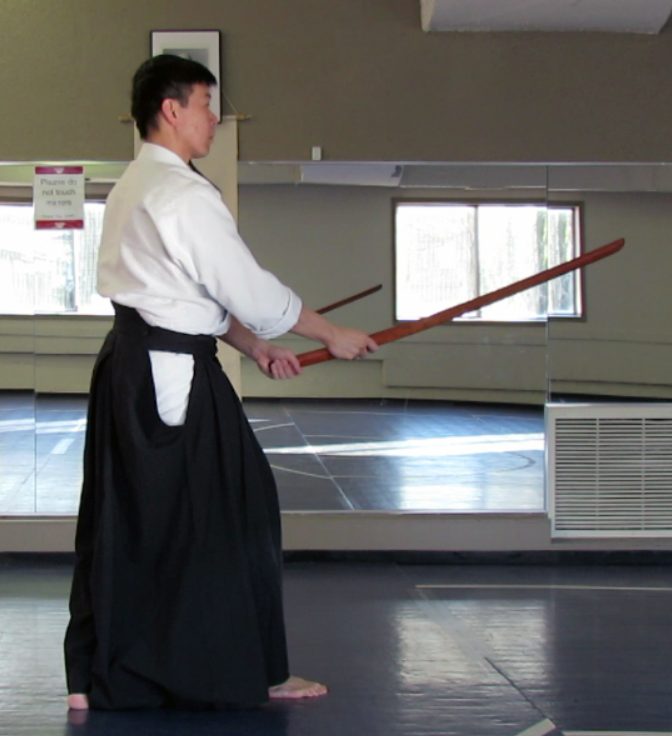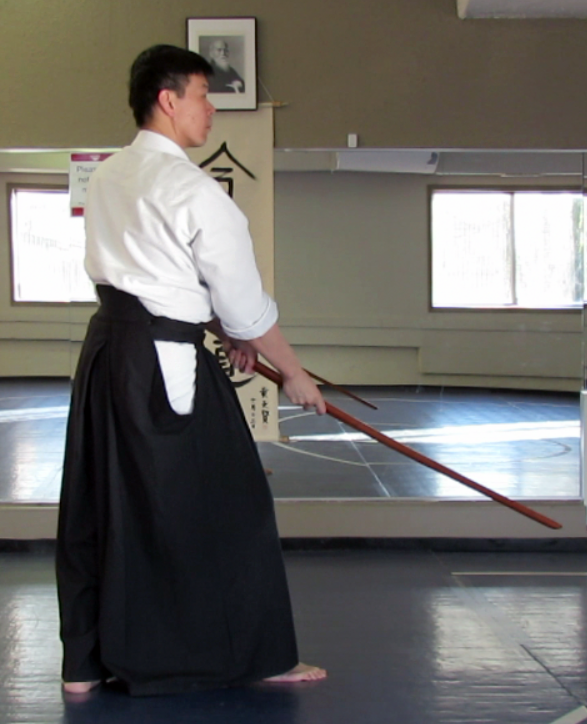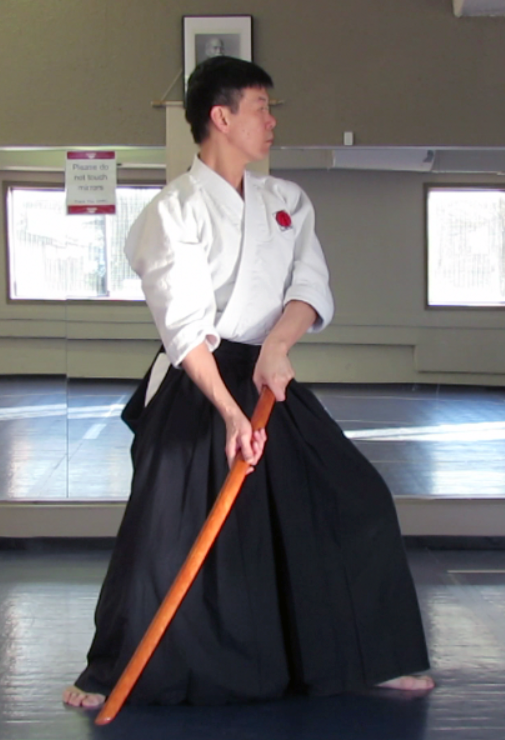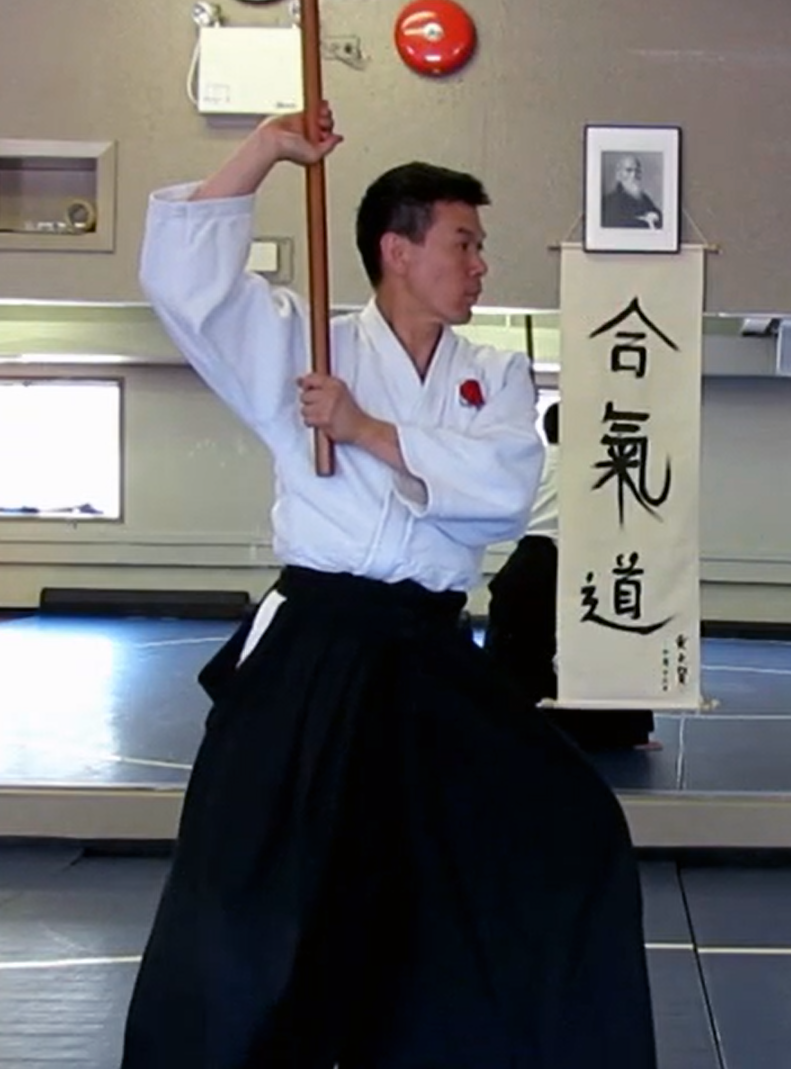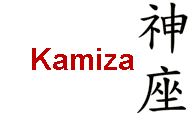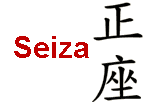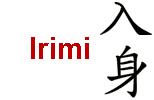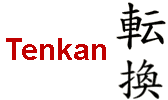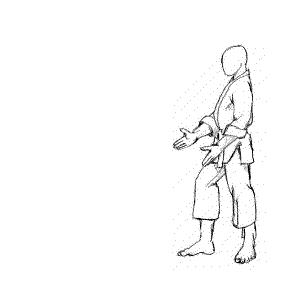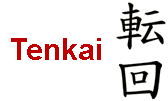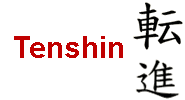The Glossary
© Ueshiba Aikido Victoria, BC, Canada: OWH IndustriesATTACKS:
AI (ah-yee) : facing your partner - same hand grab (right to right hand/left to left hand).
GYAKU (yah-kuh) : facing your partner - opposite hand grab (right to left hand/left to right hand).
KATA-DORI (kah-tah-doh-ree) : shoulder grab.
KATATE-DORI (kah-tah-teh-doh-ree) : single-wrist grab.
KOSADORI (koh-sah-doh-ree) : same hand grab (katatedori ai-hanmi - right to right/left to left).
MOROTE-DORI (moh-roh-tay-doh-ree) or RYOTE MOCHI (rio-tay moh-chee) : two hands grab one wrist.
RYOTE-DORI (rio-tay-doh-ree) : both your opponent's hands grabbing one wrist each.
SHIME (she-may) : to squeeze or choke.DOJO (doh-joe) : place of the Way; a place for strengthening and refining the body, mind and spirit.
DOMO ARRIGATO GOZAIMASHITA (doh-moh-ari-gah-toh-go-zai-mas-tah) : formal reply "thank you very much."
DOMO ARRIGATO GOZAIMASU (doh-moh-ari-gah-toh-go-zai-mas) : formal "thank you."
DOGI (doh-ghee) : also KEIKOGI (kay-koh-ghee); white training uniform.
HAKAMA (ha-ka-ma) : Traditional outer garment that resembles large-wide pants. It has seven pleats and a koshiita - i.e. a stiff or padded part in the lower back of the wearer.
KAMAE (kah-mah-ey) : posture of readiness.KAMAE POSITIONS
- Chudan
- Jodan
- Gedan
- Waki
- Hasso
CHUDAN (choo-dahn) : middle / centre position - normal kamae stance.

JODAN (jaw-dahn) : high / upper position - raising the weapon to the forehead.
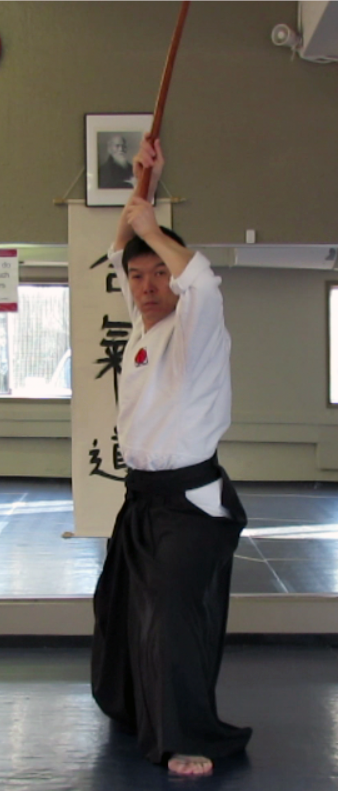
GEDAN (gey-dahn) : low position.
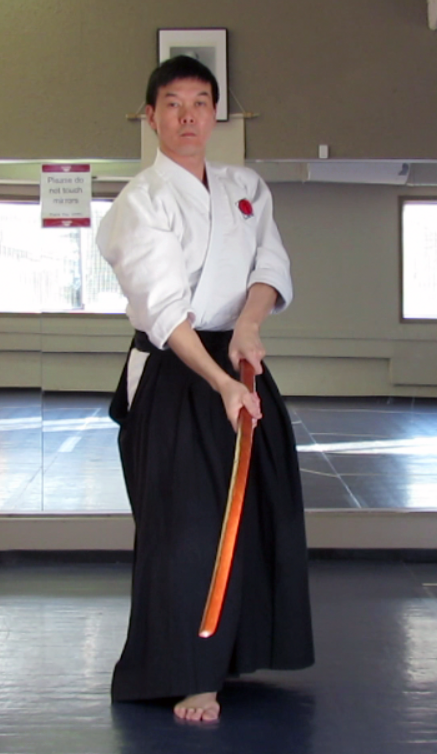
WAKI (wah-ki) : holding the weapon by one's side, sometimes to hide its length. In our dojo, it is held at the side with both hands, in an unbroken line extending from the left arm to the kissaki of the sword.
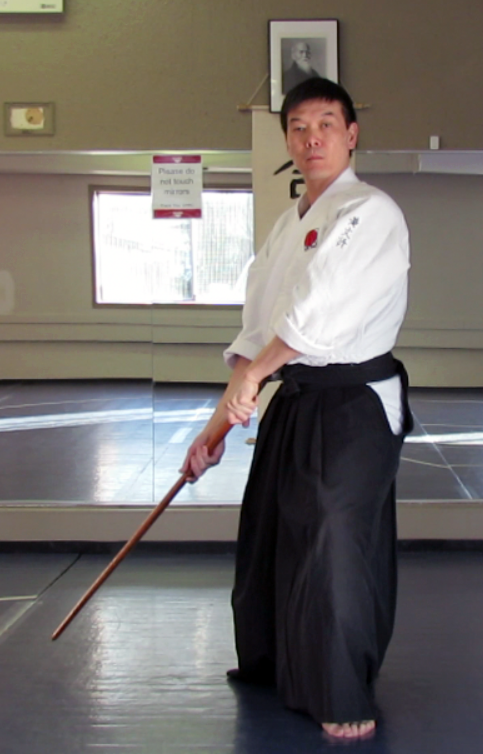
HASSO (hah-soh) : with the weapon held above the right or left shoulder, the student is able to respond in all directions.

KAMIZA
KAMIZA (kah-mee-zah) : translated as "seat of the god" where the picture of the founder and words AI-KI-DO are located at the front of the dojo (Shomen).
The Kamiza is also known as the 'upper seat' or literally translated as 'seat of god'. Located at the 'shomen' or front/correct facing of the dojo, this wall is sometimes referred to as the 'north wall'. The dojo entrance would traditionally be located on the opposite wall, known as the 'lower seat' or 'shimoza'.
The Kamiza may have a raised platform (known as the 'shinden'), where the founder of the ryu, visiting dignitaries, or chief instructor would sit while the class is in progress. In most dojos today, the shinden is more symbolic, rather than an actual platform for sitting. (See also, The Dojo)KEIKO (kay-koh) : practice.
MAAI (mah-aye) : proper distance from the opponent.MAAI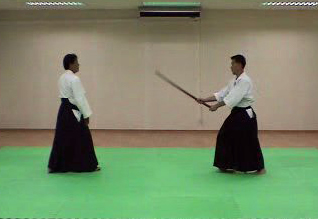
This is the distance between Tori (Nage) and Uke; between you and your opponent. This distance will vary according to the size and height of the attacker, and if the attacker has a weapon. At a comfortable distance, Tori (you) should be able to take in the full view of your opponent from head to toe. The distance should also force your opponent to advance toward you in order to reach you.
NAGE (nah-gay) or TORI (tor-ree) : the person applying a technique.
OBI (oh-bee) : the belt.
TYING THE OBI
ONEGAISHIMASU (oh-nay-gai-shmas) : "please" or asking a favor, in this case, to train together.
REI (ray-ee) : respect, normally shown through a bow or formal bow (seated).
SEIZA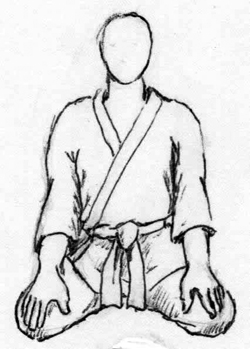
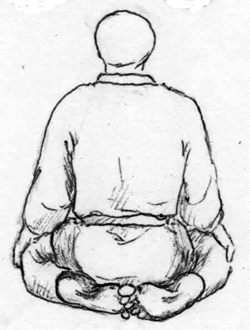
SEIZA (say-zah) : formal sitting position; the only proper sitting posture on the mat. When Sensei approaches to explain or demonstrate a technique, sit in this manner while listening and watching.
To be comfortable, sit upright with both feet forming a depression to sit in. Place the right big toe over the left big toe. Remain alert and respectful, while sitting with a relaxed mind.SHIHO (shee-ho) : literally means (the number) "four".
SHIKKOSHIKKO (shee-koh) : knee-walking. Practising Shikko develops centredness, posture, and strengthens the thighs and hips. Keep the body upright, and the feet under, for balance. Progress along a straight line with the body aligned at a diagonal while 'walking' on one's knees. The head should remain focused forward as the body advances. Basic Shikko prepares the student to perform Suwari-waza techniques.
UCHI (oo-chee) : strike
STRIKESAGE UCHI (ah-gay oo-chee) : rising cut / strike.
ATEMI (ah-tay-mee) : A distraction, or blow/strike, as a counter attack/response.
MUNE-TSUKI (moo-nay-chu-kee) : thrust (punch) to the chest (solar plexus).
NANAME UCHI (nah-nah-may oo-chee) : slanted, diagonal strike, a more acute angle than Yokomenuchi.
SHOMEN-UCHI (show-men-oo-chee) : vertical strike (chop) down to the top of the head.
SHOMEN-TSUKI (show-men-chu-kee) : thrust (punch) to the face.
TSUKI (chu-kee) : thrusting or punch.
YOKOMEN-UCHI (yeoh-koh-men-oo-chee) : diagonal strike (chop) to the side of the head / neck.UCHI-DESHI (oo-chee-day-shee) : live-in disciple who trains and serves the master.
UKE (oo-kay) : literally means "to receive"; the person who attacks and receives the response.
UKEMI (oo-kay-mee) : the art of receiving and "falling".
UKEMI - BREAKFALL
UKEMI - MAE UKEMI (FORWARD ROLL)
UKEMI - USHIRO UKEMI (BACKWARD ROLL)
Positions / Directions:
HANMI (hah-mee) : relaxed triangular (T) "half-body" standing position.
HIDARI (hee-dah-ree) : left side.
MIGI (mee-ghee) : right side.IRIMI - Movement
IRIMI (ee-ree-mee) : stepping, or gliding forward to enter into the centre of the attack to unbalance.
TENKAN - Movement
TENKAN (teng-kahn) : turning away or pivoting.
TENKAI - Movement
TENKAI (ten-kahee) : Side step, perform an atemi, step forward, and turn.
TENSHIN - Movement
TENSHIN (teng-shin): slide (to the side) and turn.
MAE (mah-ey) : forward.
OMOTE (oh-moh-tay) : to the front or 'live' side of the opponent.
SHOMEN (show-men) : the front or top of head; also upper seat on the mat and the front of the dojo.
SOTO (soh-toh) : outside.
UCHI (oo-chee) : inside.
URA (oo-rah) : to the rear on the opponent's "blind side".
URA-WAZA (oo-rah wah-zah) : turning and blending around the opponent's "blind side", to the back.
USHIRO (oo-shee-roh) : to the rear or behind the opponent (ie the back).
YOKO (yeoh-koh) : means "horizontal" - although the strike follows a diagonal path in Aikido practice.Techniques:
IRIMI-NAGE (ee-ree-mee-nah-ge) : entering throw.
SHIHO-NAGE (shee-ho-nah-ge) : four-direction throw.
KAITEN-NAGE (kahee-ten-nah-ge) : open-and-turn throw / rotary throw.
KOKYU-HO-NAGE (koh-kiu-ho-nah-ge) : "breath" throw.
TENCHIN-NAGE (tien-chin-nah-ge) : literally means "heaven and earth" throw.
KOTE-GAESHI (ko-tay-gai-she) : wrist twist throw / lock.OMOTE-WAZA (oh-moh-tay-wah-zah) : forward techniques, into the 'live' side of attacker.
URA-WAZA (oo-rah-wah-zah) : pivoting around the side, into the 'blind' side of the attacker.
USHIRO-WAZA (oo-shee-roh-wah-zah) : rear techniques.
OSAE-WAZA (oh-zah-ey-wah-zah) : pinning techniques.IKKYO (ee-kyoh) : First teaching/ first pin.
NIKYO (nee-kyoh) : Second teaching/ second pin - wrist lock.
SANKYO (sahn-kyoh) : Third teaching/ third pin - hand twist lock.
YONKYO (yong-kyoh) : Fourth teaching/ fourth pin - forearm nerve lock.
GOKYO (gor-kyoh) : Fifth teaching/ fifth pin - grab back of wrist.JO-DORI (joh-doh-ree) : short-staff take-away techniques.
TACHI-DORI (tah-chee-doh-ree) : bokken/sword take-away techniques.TANTO-DORI (tahn-toh-doh-ree) : knife take-away techniques
- Tsuki Kotegaeshi: Ura
- Tsuki Nikyo: Omote
- Yokomenuchi Kotegaeshi: Omote
- Yokomenuchi Shiho Nage: Omote
- Yokomenuchi Irimi Nage: Ura
- Ushiro Tanto Dori Sankyo: Ura
Tsuki Kotegaeshi Ura Waza
When faced with a weapon, wait for the attacker to commit to the attack. Then either turn away from the target point or move deep into the attacker's centre to deliver an atemi to the face. Moving to a position beside, or taking over the attacker's centre are crucial as it puts you in a safer position than in front of the weapon - especially if the attacker retracts their arm to begin repeated stabs, or to slash. After taking control of the weapon-hand, point the weapon back to the attacker's face when performing the technique, to discourage any counter they might try.
Lastly, while it is important to respond immediately to move to a safer position to avoid the cut of the knife or the barrel of the gun, be prepared to be hurt as well. In a weapon attack, there are no guarantees. To minimize contact with the weapon, we practice moving away from the danger zone into the heart of the source.
Tsuki Nikyo Omote Waza
When faced with a weapon, wait for the attacker to commit to the attack. Then either turn away from the target point or move deep into the attacker's centre to deliver an atemi to the face. Moving to a position beside, or taking over the attacker's centre are crucial as it puts you in a safer position than in front of the weapon - especially if the attacker retracts their arm to begin repeated stabs, or to slash. After taking control of the weapon-hand, point the weapon back to the attacker's face when performing the technique, to discourage any counter they might try.
Lastly, while it is important to respond immediately to move to a safer position to avoid the cut of the knife or the barrel of the gun, be prepared to be hurt as well. In a weapon attack, there are no guarantees. To minimize contact with the weapon, we practice moving away from the danger zone into the heart of the source.
Yokomenuchi Kotegaeshi Omote Waza
When faced with a weapon, wait for the attacker to commit to the attack. Then either turn away from the target point or move deep into the attacker's centre to deliver an atemi to the face. Moving to a position beside, or taking over the attacker's centre are crucial as it puts you in a safer position than in front of the weapon - especially if the attacker retracts their arm to begin repeated stabs, or to slash. After taking control of the weapon-hand, point the weapon back to the attacker's face when performing the technique, to discourage any counter they might try. Notice how atemi is applied more than once, especially when moving in front of the attackers face.
Lastly, while it is important to respond immediately to move to a safer position to avoid the cut of the knife or the barrel of the gun, be prepared to be hurt as well. In a weapon attack, there are no guarantees. To minimize contact with the weapon, we practice moving away from the danger zone into the heart of the source.
Yokomenuchi Shiho Nage Omote Waza
When faced with a weapon, wait for the attacker to commit to the attack. Then either turn away from the target point or move deep into the attacker's centre to deliver an atemi to the face. Moving to a position beside, or taking over the attacker's centre are crucial as it puts you in a safer position than in front of the weapon - especially if the attacker retracts their arm to begin repeated stabs, or to slash. After taking control of the weapon-hand, point the weapon back to the attacker's face when performing the technique, to discourage any counter they might try. Notice how the attacker's wrist is bent towards them when moving in front of the attacker.
Lastly, while it is important to respond immediately to move to a safer position to avoid the cut of the knife or the barrel of the gun, be prepared to be hurt as well. In a weapon attack, there are no guarantees. To minimize contact with the weapon, we practice moving away from the danger zone into the heart of the source.
Yokomenuchi Irimi Nage Ura Waza
When faced with a weapon, wait for the attacker to commit to the attack. Then either turn away from the target point or move deep into the attacker's centre to deliver an atemi to the face. Moving to a position beside, or taking over the attacker's centre are crucial as it puts you in a safer position than in front of the weapon - especially if the attacker retracts their arm to begin repeated stabs, or to slash. After taking control of the weapon-hand, point the weapon back to the attacker's face when performing the technique, to discourage any counter they might try.
Lastly, while it is important to respond immediately to move to a safer position to avoid the cut of the knife or the barrel of the gun, be prepared to be hurt as well. In a weapon attack, there are no guarantees. To minimize contact with the weapon, we practice moving away from the danger zone into the heart of the source.
Ushiro Tanto Dori Sankyo Ura Waza
When faced with a weapon, wait for the attacker to commit to the attack. Then either turn away from the target point or move deep into the attacker's centre to deliver an atemi to the face. Moving to a position beside, or taking over the attacker's centre are crucial as it puts you in a safer position than in front of the weapon - especially if the attacker retracts their arm to begin repeated stabs, or to slash. After taking control of the weapon-hand, point the weapon back to the attacker's face when performing the technique, to discourage any counter they might try. While this technique was performed at a slower pace, notice that it is important to turn quickly to perform an atemi to the face of the attacker, and not to grab the weapon-hand. Remember to point the weapon to the attacker, or perform atemi when facing the attacker head-on.
Lastly, while it is important to respond immediately to move to a safer position to avoid the cut of the knife or the barrel of the gun, be prepared to be hurt as well. In a weapon attack, there are no guarantees. To minimize contact with the weapon, we practice moving away from the danger zone into the heart of the source.
Weapons:
Traditionally, Jo and Bokken practice in Ueshiba Aikido dojos are reserved for 4th Kyu students and above. Tanto (knife) takeaways may be practiced from 6th Kyu.
The basic premise is to enable the beginning practitioner to first find their own balance whilst performing basic unarmed techniques. When the student is able to perform unarmed techniques fairly competently, then weapons are introduced in stages. By this time, the student would be able to experience the weapon as an extension of the body and not as an external object.
Webpages & Illustrations by Rafael Oei Victoria, BC, Canada
Updated: 24 February, 2021

